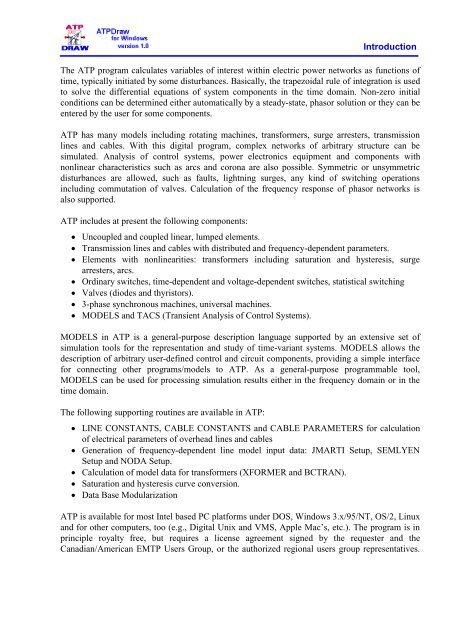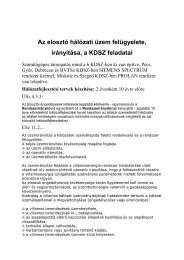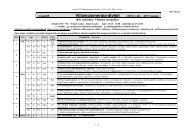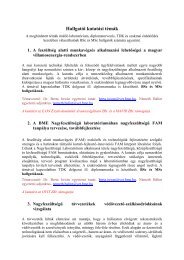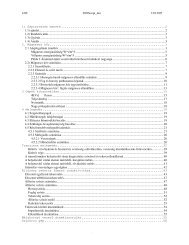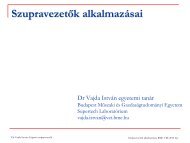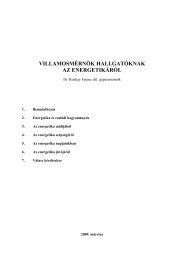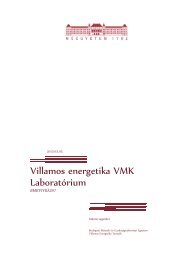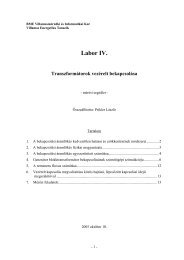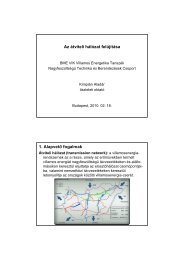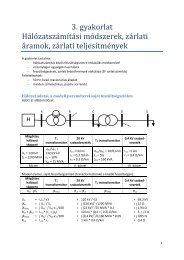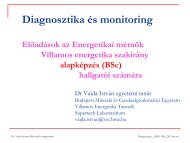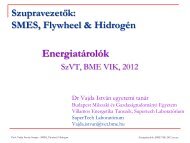Szimmetrikus összetevÅk vizsgálata - Villamos Energetika Tanszék
Szimmetrikus összetevÅk vizsgálata - Villamos Energetika Tanszék
Szimmetrikus összetevÅk vizsgálata - Villamos Energetika Tanszék
Create successful ePaper yourself
Turn your PDF publications into a flip-book with our unique Google optimized e-Paper software.
Introduction<br />
The ATP program calculates variables of interest within electric power networks as functions of<br />
time, typically initiated by some disturbances. Basically, the trapezoidal rule of integration is used<br />
to solve the differential equations of system components in the time domain. Non-zero initial<br />
conditions can be determined either automatically by a steady-state, phasor solution or they can be<br />
entered by the user for some components.<br />
ATP has many models including rotating machines, transformers, surge arresters, transmission<br />
lines and cables. With this digital program, complex networks of arbitrary structure can be<br />
simulated. Analysis of control systems, power electronics equipment and components with<br />
nonlinear characteristics such as arcs and corona are also possible. Symmetric or unsymmetric<br />
disturbances are allowed, such as faults, lightning surges, any kind of switching operations<br />
including commutation of valves. Calculation of the frequency response of phasor networks is<br />
also supported.<br />
ATP includes at present the following components:<br />
Uncoupled and coupled linear, lumped elements.<br />
Transmission lines and cables with distributed and frequency-dependent parameters.<br />
Elements with nonlinearities: transformers including saturation and hysteresis, surge<br />
arresters, arcs.<br />
Ordinary switches, time-dependent and voltage-dependent switches, statistical switching<br />
Valves (diodes and thyristors).<br />
3-phase synchronous machines, universal machines.<br />
MODELS and TACS (Transient Analysis of Control Systems).<br />
MODELS in ATP is a general-purpose description language supported by an extensive set of<br />
simulation tools for the representation and study of time-variant systems. MODELS allows the<br />
description of arbitrary user-defined control and circuit components, providing a simple interface<br />
for connecting other programs/models to ATP. As a general-purpose programmable tool,<br />
MODELS can be used for processing simulation results either in the frequency domain or in the<br />
time domain.<br />
The following supporting routines are available in ATP:<br />
LINE CONSTANTS, CABLE CONSTANTS and CABLE PARAMETERS for calculation<br />
of electrical parameters of overhead lines and cables<br />
Generation of frequency-dependent line model input data: JMARTI Setup, SEMLYEN<br />
Setup and NODA Setup.<br />
Calculation of model data for transformers (XFORMER and BCTRAN).<br />
Saturation and hysteresis curve conversion.<br />
Data Base Modularization<br />
ATP is available for most Intel based PC platforms under DOS, Windows 3.x/95/NT, OS/2, Linux<br />
and for other computers, too (e.g., Digital Unix and VMS, Apple Mac’s, etc.). The program is in<br />
principle royalty free, but requires a license agreement signed by the requester and the<br />
Canadian/American EMTP Users Group, or the authorized regional users group representatives.


